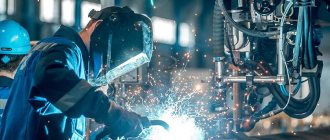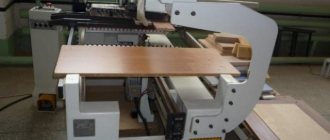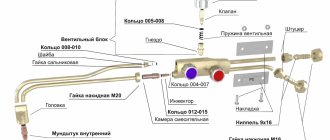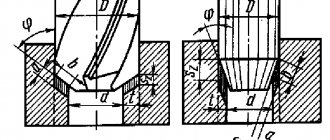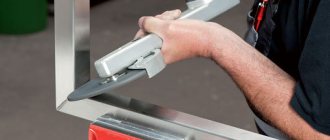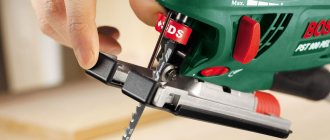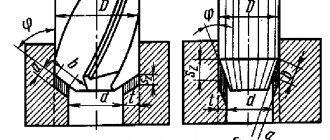The petrol cutter is an autonomous multifunctional equipment used during repair and construction work, restoration or partial replacement of asphalt pavement or railway tracks. It is used to cut concrete, metal, various types of natural stone, brick, and reinforced concrete structures. The operating principle of the tool is based on the fact that a two-stroke carburetor internal combustion engine rotates the cutting disc. When the cutting attachment comes into contact with the surface of the material, it is sawed.
Petrol cutter Husqvarna K750 (Husqvarna): purpose, performance characteristics, operating procedure
Compact design and functional ergonomics, as well as a modern and compact design, the HUSQVARNA K750 has a clear resemblance to other models of this brand.
The one-piece motor housing has a rounded, smooth outline that allows you to comfortably press it with your foot or thigh when you need to apply a little more force. For a comfortable working position and reducing the load on the user, the distance between the handles is made large. The K750's handle design and short engine frame keep the operator close to the machine, making it easier to handle and control.
For even more comfortable operation of the machine, the front handle has a completely new, thicker design that provides a more comfortable grip. New exclusive DualCharge engine technology delivers exceptionally high 3.7 kW engine power with low emissions and impressive fuel economy. The engine power reaches 5 hp, the cylinder volume is 74 cm3. When idling, the model reproduces 2700 rpm at minimum speed and 9300 (+-150) at maximum speed without load. An anti-vibration system and coolant are used as additional functions.
In short, a cleaner and more efficient engine. The HUSQVARNA K750 cutter also features a large, efficient muffler, an automatic decompression valve and a new vibration absorption system that makes the machine exceptionally quiet and easy to operate. The fuel tank, handle and air intake system are a completely vibration-free unit, resulting in exceptionally low handle vibration (less than 5 m/s2).
The muffler dimensions have been doubled. Along with the larger air intake, this makes the engine quieter and more efficient. The device weighs 9.4 - 9.8 kg (depending on the diameter of the end machine), and is equipped with active air filtration, which reduces maintenance costs. The SmartCarb series carburetor ensures stable power.
The methodological plan, synopsis and instruction manual are available by clicking the “DOWNLOAD” button after the article
What is a petrol cutter?
The tool is a self-contained yet compact circular saw equipped with a special rotating disk with a cutting edge. A petrol cutter is a device that, unlike its close relative, is capable of cutting hard rocks and materials. Thanks to the high speed of rotation of the disk, the tool can cut various products of impressive thickness in a short period of time. The main advantage is the ability to be used where there is no electricity. Today, the market offers household, semi-professional and professional models.
Petrol cutter device
When purchasing such a tool, it is important to understand that this is the most massive equipment, so special transport carts will be needed to use it. Regardless of the model, the main elements of the device are:
- frame;
- engine;
- chain drive;
- coated disk;
- lever;
- protective casing.
The cost of the product is directly related to the quality and size of the disc. Petrol cutters for metal are divided into groups for wet and dry cutting. In the first version, the device is additionally equipped with a casing with liquid supplied through special tubes to the material being processed and the disk. The cost of this equipment is much higher than those that do not have it.
The principle of operation of a gas cutter
The engine runs on a mixture of gasoline and oil. After switching on, the disk begins to perform rotational movements, due to which the desired surface is cut. To understand how to work with a gas cutter, it is worth knowing the features of these manipulations:
- the cutting depth is limited by the diameter of the disk;
- It is recommended to use a small sector when cutting;
- The gas cutter must be held at right angles to the surface being worked on;
- special wheels are used to cut different materials;
- Diamond discs are consumables that quickly deteriorate.
Intensity of use
Currently, professional and household models are available on the market, the main differences between which are working life, design and functionality. Regarding the first, household gas cutters are designed for approximately 25 hours of operation per month. They have low power and are suitable for small volumes of work. A professional tool has a wider range of applications, and its working life is about 8 hours of continuous operation.
Advantages and disadvantages
The main advantage of a gas cutter over other special devices for cutting materials is its mobility and ease of use. A running gasoline engine is not connected to a source of electricity; the equipment is convenient to use for working in remote locations. The most durable materials can be cut - granite, reinforced concrete, other types of concrete, natural stone. The cutting depth directly depends on the diameter of the cutting element - some models reach 40 cm.
When cutting, the mechanism is predominantly held in the hands, hence the high maneuverability. There are devices with a cooling and water supply system - this allows you to work for a long time without turning off the device and without fear of overheating. Water circulation reduces the amount of dust generated during cutting - an important point when working indoors; a significant accumulation of dust makes breathing difficult and interferes with visibility.
Return to contents
How to choose a gas cutter
Before purchasing expensive equipment, it is important to know its characteristics. The choice of tool depends on the purpose for which and how often it will be used. In addition, it is important to consider the ease of use of the tool.
Characteristics to consider when choosing a gas cutter:
- Shape and dimensions of equipment;
- Set of functions;
- Engine power;
- Petrol cutter weight;
- Water supply system to the surface being treated and parts of the tool;
- Ease of operation and maintenance;
- Cutting ability of equipment.
One of the most important parameters is the ease of use of the tool.
A petrol cutter is a traumatic equipment that, if used incorrectly, can cause harm to the person working with it. Based on this, it is worth considering whether it is comfortable for the future owner to hold the instrument in the hands, because his physical health depends on this.
What is better: a gas cutter or a gas cutter?
You can compare tools for working with metal. You can understand which option is better by becoming familiar with the basic operating parameters of these devices. Let's look at the most important ones:
- The petrol cutter cuts the material due to the rotation of the disk. Gas cutting results in the combustion of metal in a stream of pure oxygen.
- Some types of products cannot be separated using a gas cutter; with a gas cutter, only thickness can become a problem.
- In terms of weight, a gas-powered device wins, because the operator only has to hold the burner itself, which, due to its size, weighs little. The cylinder is on the floor.
- For safety reasons, it is better to deal with a gas cutter. If you follow the operating rules, no problems should arise. Working with gas requires some special features regarding the placement of the cylinder and working conditions. In addition, interaction with gas is carried out with a welder’s mask.
Rules for cutting materials
Concrete and metal, as well as their connection (reinforced concrete structures) are the main materials that most often have to be cut using a gasoline cutter. Working with a gas cutter requires compliance with the following general rules.
- It is first necessary to apply marking lines on the working surface.
- Sawing must be carried out at maximum engine speed, which should be reached before the disc comes into contact with the material.
- Cuts should only be made in straight lines.
- The instrument should be held firmly with both hands, without allowing springy movements or swings. It is necessary that the cutting edge of the nozzle contacts the surface of the material smoothly.
- During long working periods, it is necessary to take periodic rest breaks, during which the equipment will also cool down.
- Do not apply excessive force to the power tool so that its disk does not jam and overload occurs.
- During work, it is necessary that the body is in a stable position.
- The depth of cut should not immediately be maximum when sawing massive parts: you need to cut the groove in several approaches.
- When cutting large pipes, the circular cut should also not be made straight through, so that the disk does not get pinched and the gas cutter is thrown off.
- You cannot hold a working unit over your head.
- Whenever possible, materials should be cut securely, or large workpieces should be positioned so that the cutting attachment does not become pinched.
- Discs cannot be used for grinding.
Working with metal and concrete has its own characteristics. First of all, various cutting attachments are used in the cutting process:
- concrete is sawed using steel discs with a diamond-coated cutting edge;
- Abrasive wheels are used to cut metal.
It should also be taken into account that working attachments can be designed only for cutting materials using a wet or dry method, or both at once. The purpose of cutting wheels is indicated on the labels affixed to their front side. Manufacturers indicate that for diamond discs, the direction of rotation is an important point: if it does not coincide with that indicated on the label, the diamond coating will wear out much faster. The remaining nuances of cutting concrete and metal should be considered separately.
Working with metal
Cutting metal does not require the use of such powerful gas cutters as when sawing concrete. Typically, gas powered tools up to 4200 W are used.
When working with metal, you should follow these recommendations.
- Hold the tool at a 90 degree angle to the surface of the material being cut while making a vertical cut.
- The protective cover must be tilted so that sparks fly forward (away from the worker).
- You must first touch the metal with a disk rotating at medium speeds, and only after creating a guide groove, cut in at maximum speed.
- To achieve a smooth, even cut, the tool must be moved in a leisurely, forward motion without unnecessary pressure.
- Thin metal pipes, sheets, rods can be sawed immediately with a vertical cut.
- Iron corners or I-beams must be cut in pieces, working especially carefully in places where structural elements touch at angles, because the slightest distortion will cause the disk to jam, followed by the gas cutter being pulled out of your hands.
- If the material is under tension, then first make a cut from the working side, and then from the opposite side to avoid pinching.
In the cutting area, the metal gets very hot (and sometimes melts), so you should not touch the cut area until it cools down, otherwise you can get a severe burn.
Concrete cutting
Gas cutters with a power of 4200 W and a blade speed of approximately 4700 rpm are designed for sawing concrete. Such characteristics are necessary to ensure high performance.
Concrete cutting is performed using two methods:
- dry;
- wet.
When sawing concrete, which is a mineral material, a lot of dust arises. The dry method does not involve supplying water to the cutting site. For this reason, when working with this method, the use of safety glasses with a respirator is required. Approximately every 30 seconds it is necessary to take breaks in operation to allow the disk to cool.
Gasoline tools designed only for dry work are cheaper than analogues with the possibility of wet cutting, but the process of sawing concrete with their help lasts much longer, accompanied by significant dust. Periodic watering of the cutting area with water helps to partially reduce the amount of dust. The dry sawing method is only suitable for small volumes of work.
The wet cutting method differs in that water enters the cutting area through tubes attached to the protective casing. It cools the disk and suppresses dust. The duration of the work process is significantly reduced due to the fact that frequent breaks are not required. Also, the presence of a water cooling system allows you to increase the service life of not only the cutting attachment, but also the gas cutter itself. The wet method is used for significant volumes of work.
When starting to saw concrete, you should consider the following.
- If the concrete structure exceeds 100 mm in thickness, then it is most likely reinforced, and this must be taken into account when choosing a suitable disc.
- To evaluate the performance of the gas cutter, it is recommended to first make a cut up to 1 cm deep. This will allow you to determine the approximate amount of time that will need to be spent on the work.
- The insertion will be simplified by attaching a wooden block along the cutting line (especially if the monolith is of significant strength), which will need to be removed after creating a groove of the required depth.
Regardless of the cutting method you choose, you must follow the general rules discussed above. Concrete is also often sawed with hand chain saws. They work like chainsaws.
Maintenance
Below are some general routine maintenance instructions. If you have any further questions, please contact your dealer.
Maintenance instructions
Daily
- Check the safe operation of the throttle handle parts (throttle handle and starting throttle lock).
- Check the drive belt tension.
- Check the condition of the blade and drive wheel.
- Check the condition of the blade guard.
- Check the starter and starter cord and clean the outside of the starter air intake.
- Check the tightness of the nuts and bolts and tighten if necessary.
- Check the operation of the stop contact.
Weekly
- Check, clean or replace the plastic filter.
- Check the handles and vibration dampers to ensure they are not damaged.
- Clean the spark plug. Check the gap 0.5 mm.
- Inspect the starter and return spring. Clean the intercostal space on the flywheel.
- Clean the cylinder cooling fins.
- Check that the muffler is firmly attached and not damaged.
- Check the idle speed setting and adjust if necessary.
Types of gas cutters
Depending on the properties of the material being processed, tools fall into the following categories:
- For metal
. Power up to 4.2 kW. - On concrete
. Power more than 4.2 kW. The chain cutter for concrete has a disk rotation speed of 4.7 thousand revolutions/min. - Universal models
. The tools are endowed with the highest performance, as they are designed to work with different types.
In addition, there is a division according to purpose into:
- Rail cutters
- there is a mechanism that significantly expands the depth of cut. Used by railway line installers. - Wall chaser
- works with two diamond-coated discs. Used to create grooves for electrical wiring in various surfaces. - Chain cutter
- the tool looks like a gasoline saw; a diamond chain allows you to cut both metal and stone. - Chrome-plated gas cutters
- used for rescue operations.
Security requirements
To avoid injury during operation, gas cutters are equipped with cast protective casings made of hard metal alloys with high impact resistance. In addition, global manufacturers use a system for blocking the disk when it gets stuck in the material being processed, and also supply the manufactured tools with belt and casing tensioning devices.
When working with a gas cutter, it is recommended to use protective gloves, glasses and headphones, and when dry cutting - respiratory protection.
Scope of application
Due to their autonomy, gas cutters can be used in any place inaccessible to a power tool. Their main area of application is various open construction sites. These tools are actively used in summer cottages and country cottages, as well as in finishing industrial premises where electricity is not provided.
Petrol cutters are actively used by rescue and fire services around the world. With the help of such a tool, you can quickly enter a closed room, open the body of a car, or dismantle a blockage. Autonomous circular saws are used when performing high-rise work, repairing industrial equipment and road infrastructure. Along with gas torches, gas cutters are used when cutting steels with low carbon content.
Benefits of a gas cutter
The main difference between a gas cutter and other types of cutting tools is its ability to cut hard materials. They can be used not only on construction sites, but also indoors. The tool can be powered from the mains or from a rechargeable battery.
This tool eliminates the need for a lot of equipment. They can be used to cut metals, concrete, bricks, asphalt and more. Petrol cutters are used during the construction or dismantling of entire buildings or small structures.
Characteristics of gas cutters
The modern market offers a wide selection of different models. According to consumer reviews, the greatest demand is for semi-professional options that cost less and perform multiple tasks. This type of autonomous circular saw has the following characteristics:
- tool design;
- equipment power - on average 3-3.5 kW;
- cutting height - approximately 125 mm;
- disk diameter - about 350 mm;
- diameter of the mounting hole is on average 20 mm;
- engine volume - on average 65-75 cm³;
- tank capacity - approximately 0.65-0.7 l;
- noise level - approximately 95-100 dB;
- instrument weight - about 9.5-12 kg;
- additional functions.
9. Husqvarna K 760 Cut-n-Break - from RUB 108,482.
The unique Husqvarna gas cutter cuts to a depth of up to 400 mm.
Suitable for builders who cut a lot of door and window openings. But the price is also high, so you have to calculate the benefits of using such a tool. But it is cheaper than using a large wall saw - such a device is more compact, and there are fewer diamond blades and therefore cheaper. As for the technical side, everything is sound, high quality and reliable. There is a wet cutting function. Specifications Husqvarna K 760 Cut-n-Break
| Characteristic | Meaning |
| Weight, kg. | 11,1 |
| Cutting depth, mm. | 400 |
| Rotation speed, rpm | 4400 |
| Power, hp | 5 |
| Disc diameter, mm. | 230 |
| Diameter of seat, mm. | 20 |
| Noise level, dB | 113 |
| Development/production | Sweden |
In the following video you can see the technology for sequential cutting of a window opening using this model:
And here is the same video, but filmed live. Not so accessible, but spectacular:
Disc for gas cutter
The division is carried out according to several criteria. Depending on the material that needs to be cut, discs come in the following types:
- For metal
. For working with different products and workpieces. - On wood
. The disc has sharp teeth located along the entire edge. - By stone
. There is diamond coating on the edge of the disc. - On concrete
. Presence of thick diamond coating. - For reinforced concrete
. Used where reinforcement is present.
In addition, the division occurs based on the appearance of the disk:
- Turbo disk
. A universal option for any type of cutting. Wave-shaped edge with slanted grooves. By reducing the thickness of the circle on the gas cutter, natural cooling of the disc occurs. - Solid
. Solid version with continuous diamond edge. Carry out wet cutting. - Segmented
. The edge has slots that help cool the blade during operation. Used for dry cutting.
User manual
The concrete and metal cutter is an extremely dangerous tool - a rotating diamond blade can easily cause serious injury or death.
- Be properly equipped, watch the training video, read the instructions - they usually come included.
- Manufacturers do not recommend carrying out complex maintenance outside of dealerships or specialized centers; this also applies to making independent changes to the design of devices.
- Be sure to wear protective equipment while working. A helmet, headphones, a respirator and gloves do not eliminate the risk of injury, but they can reduce their fatality and make work more comfortable.
- Follow fire safety rules - engine exhaust gases are very hot and may contain sparks; if you work in unventilated areas or near flammable materials, they can cause a fire.
- Do not forget to pay attention to timely inspection and maintenance of the device.
By adhering to these simple rules, you will protect yourself and others, and extend the durability and efficiency of use.
Rating of petrol cutters
To make the right choice, it is recommended to first get acquainted with the models that are very popular. The best gas cutter should be chosen from the following list:
- Stihl TS 420
. Low vibration and comfortable handle shape allows you to work in any position. - Husqvarna K 760
. The petrol cutter quickly copes with the assigned tasks in the most emergency situations. - Makita DPC 6431
. Reinforced aluminum casing for low vibration. - Partner K 750
. The body of the model is shortened, which helps control the process. - Hilti DSH 900-X
. It has a powerful motor, reinforced with a protective casing. - Hitachi CM75EAP
. The cheapest tool. Suitable for cutting metal. - Echo CSG-680
. Manual petrol cutter with automatic ignition advance system. - Wacker Neuson BTS 635
S. A simple device with a durable body and good dust and moisture protection. - Oleo-Mac 983TTA-14
. Suitable for semi-professional use. - Solo 881-14
. The advantage is its lightness and good weight distribution. Technically complex device.
Oleo-Mac 983TTA-14 – RUB 73,990.
The Oleo-Mac tool requires careful attention and is capricious in terms of fuels and lubricants.
You need to monitor the tension of the drive belt. It is difficult to get spare parts for Oleo-Mac. Regarding this motor cutter, there are no critical design flaws; the model is suitable for semi-professional use. There are slight vibrations on the handle, and, subjectively, an uncomfortable grip. Characteristics of Oleo-Mac 983TTA-14
| Characteristic | Meaning |
| Weight, kg. | 11,4 |
| Cutting depth, mm. | 125 |
| Rotation speed, rpm | 4240 |
| Power, hp | 5 |
| Disc diameter, mm. | 350 |
| Diameter of seat, mm. | 25,4 |
| Noise level, dB | 118 |
| Development/production | Italy |
The video shows the model in action. You may notice difficulty starting the gas cutter - in cold weather this is normal for two-stroke engines.
Partner K 750
Partner is a subsidiary brand of Husqvarna. The design of the handles and the shortened body of the model allow maximum control over the work process. The engine design uses Dual Charge technology, which significantly reduces fuel consumption without affecting the power itself.
petrol cutter
- Compact, user-friendly design
- Economical engine
- Quiet and easy to use
- High vibration
I've been using it for quite a long time. Convenient, consumes less fuel compared to similar products. Happy with the purchase!!!
Do-it-yourself petrol cutter
To save money, craftsmen can try to assemble the instrument themselves from available materials. A petrol cutter for asphalt or other material is made from the following items:
- chainsaw;
- grinder head assembly;
- tires;
- pulleys;
- belt.
The design of a gas cutter is as follows:
- The belt is located along the axis of the tire.
- The pulley is fixed to the sprocket.
- The gear in the grinder assembly has been removed. It is machined and a pulley is made to fit its dimensions, which is welded.
- The tires are shortened and welded.
- The attachment is removable and, if necessary, the chainsaw can be used for its intended purpose.
Where can I buy?
Tools are often counterfeited; it is best to buy them at specialized dealerships and online construction stores. If there are none in your city, go to the website of the direct manufacturer on the Internet. Not all companies independently distribute their products - look for lists of official brand representatives on the Internet.
Websites of manufacturers and their representatives in Russian:
- stihl.ru
- husqvarna.com/en/
- makita.ru
- partner.biz/ru/
- hilti.ru
How to use a gas cutter?
The first thing you need to know when working with a special-purpose tool is compliance with safety precautions. It is important to use the following protection measures:
- glasses and mask;
- headphones;
- helmet;
- clothes made of thick fabric;
- closed shoes and gloves.
It is important to first check the instrument for possible damage. The correct procedure for starting a gas cutter is as follows:
- the instrument is placed on a flat surface;
- the lever is moved to the working area;
- open the air damper;
- start the engine with a sharp movement of the starter handle;
- close the air damper halfway to idle;
- release the shutter lever and press the start button.
Rules for working with a gas cutter
For high-quality and safe use, it is important to adhere to the following recommendations:
- When performing dry cutting, care must be taken to ensure that the blade does not overheat. Costs every 2 minutes. make a stop.
- A complete and compact circular saw must have a protective cover.
- It is important to remember that the gas cutter is designed for straight cutting only.
- The edge of the saw blade should smoothly touch the work material. Movements should not be sudden or with strong pressure.
- Work begins after the tool has reached the required speed.
- The cuts are not made deep to prevent pinching of the disc.
- It is prohibited to grind products with a working disc. This will lead to cracks and destruction of the cutting edge.
- The correct position of the gas cutter is on top of the work surface.
Starting the gas cutter and troubleshooting possible problems
To start a gas cutter, proceed as follows:
- place the instrument on a level place, for example, on the floor;
- with the left hand they grasp the front handle, and with the right foot they step on the back handle, pressing it against the supporting surface;
- with your right hand, pull the starter slowly for the first time until there is noticeable resistance, so that the cable is extended by 1/2, maximum 2/3 of its length;
- then pull the starter handle in a straight line several times in short, quick jerks until the engine starts.
During startup, you must carefully monitor the disc or chain so that it does not come into contact with the surface on which the power tool is lying.
It should be taken into account that the starter handle should not quickly bounce back to the unit body, and the cable should not come out all the way (so as not to break).
If the model you are using is not equipped with an electronic system that regulates its warm and cold starts automatically, then all operations will need to be carried out manually.
Starting a cold engine is done as follows:
- the air damper is pulled out all the way;
- the ignition is set to working position;
- block the throttle valve by holding the lock button;
- pressing the trigger of this damper, hold it;
- the starter starts the engine;
- use the throttle trigger to regulate (having previously unlocked it) the engine speed during operation.
It is not recommended to cut materials with the damper fully open. It should be partially covered. It is recommended to start a warm engine (not yet cooled down after work) without using the air damper. If this does not work, then you will need to use it, as with a cold start.
It happens that the engine does not start at all or starts with significant difficulties. Possible causes of problems and ways to resolve them are presented in the table below.
| Causes of the problem | Remedy |
| Ignition switch is not turned on | it is necessary to switch it to the working position |
| the fuel mixture has run out or is of poor quality or water has entered | you should fill in new fuel, pouring out the old (if any) |
| fuel filter clogged | you need to replace it with a clean one and wash the fuel supply hoses and tank |
| The spark plug is faulty or dirty | you need to install a new one or clean the old one by adjusting the distance between the electrodes |
| Magneto or wiring fault | It is recommended to contact a service center |
| the engine is full of fuel | it is necessary to crank the engine manually, with the spark plug unscrewed, which will need to be dried |
| air filter clogged | you can try to clean it or install a new one |
| carburetor adjustment is out of order | needs to be configured again |
| There is insufficient air supplied to the engine | damper needs to be adjusted |
After starting, the engine must be allowed to run for some time until its operating temperature is reached.
Design features
The main component of the gas cutter is the engine. Most often this is a two-stroke gasoline engine, running on a combustible mixture of oil and gasoline. It is enclosed in a plastic case with 2 special handles and controls. The working tool is a cutting disk with a diameter of 350-400 mm, which is connected to the engine by a drive belt.
Most models have a multi-stage dust protection system that prevents contamination of the cylinder-piston group and carburetor. In addition, water cooling of the working surface is often used. Such a system is necessary to eliminate dust microparticles from the work area and prevent wear of the cutting tool.
(1 rating, average 4 out of 5)
